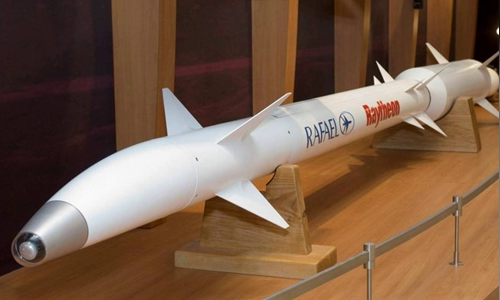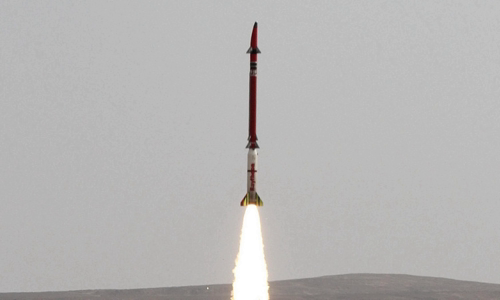Russia could develop a new anti-aircraft missile and penetrate Israel's David's Sling shield with a Stunner hit on Syrian territory.
On July 23, 2018, air defense sirens rang throughout northern Israel, when the country's army detected two OTR-21 Tochka tactical ballistic missiles launched by the Syrian army to the south. The Syrian army shoots these two missiles to attack the rebels, but the Israeli air defense mistakenly thinks they fly into airspace.

The Stunner rocket model was displayed by Israel in 2017 Photo: Rafael
Israel immediately fired two Stunner missiles from David's Sling medium-range missile defense system, during the first combat of this shield. Some information said two Stunner missiles missed the target, but Israeli media said that seconds after the launch, Israeli air defense confirmed that the flight trajectory of the Tochka missile did not invade the country's airspace. .
The squad commander David's Sling sent a self-destruct order to two rockets, one exploded in the sky, but they did not know what happened to the second. After the self-destruction order was issued, they no longer continued to follow the trajectory of the rocket.
However, the missile did not self-destruct, but fell to Syrian territory, about one kilometer from the Israeli border, in almost intact condition. The Syrian army has collected the missile and then transferred it to the Russian army for research in Moscow, although Israel and the US have called for Russia to return, according to Chinese military news site Sina.
Although the Israeli and Russian militaries have not yet commented on the information, experts say that Israel and the US will suffer significant damage if the Stunner missiles actually reach Russia.
"Stunner is integrated with many advanced technologies, surpassing all types of air defense missiles available in the world. Russia can gain valuable data when dissecting this bullet, because air defense missiles are weapons. valued strategically important to Moscow and is also a leading defense export of them, "expert Tyler Rogoway commented.
David's Sling is an advanced anti-air shield system produced by Israel's Rafael and US Raytheon Corporation, capable of shooting down missiles from a distance of 40-300 km, creating a name defense system. sophisticated multilayer fire when combined with the Iron Dome and Arrow long range interceptors.
The most special feature of Stunner is the multi-channel probe system used in the target approach phase. The tip of the missile is shaped like a dolphin nose containing a thermal image sensor, an optical-electric probe and an active electronic phase-array radar (AESA) detector.
This design makes it very difficult for the enemy to fool the Stunner, while increasing the ability to kill difficult targets such as ballistic missiles and stealth cruise missiles.
If the radar is jammed, optical - electrical and thermal imaging probes will lead the bullet to the target. In the event that the opponent lures a heat trap or activates an infrared suppression system, the radar probe will ensure the ability to lock the target while the Stunner rocket hits the target.

Stunner projectile launched in late 2015 Photo: Rafael
"The combination of the three types of sensors provides very high kill rates, as well as the ability to distinguish targets better than missiles using a single oil detector. Thermal imaging sensors can also be programmed. to identify and lead Stunner into a critical area of the target such as fighter engines or explosive warheads of ballistic missiles, "Rogoway said.
Stunner also carries advanced systems with small dimensions such as three-dimensional data transmission lines, allowing connection with guided radar and changing targets after leaving the launcher. The manufacturer does not disclose the maximum speed of the Stunner, but it can hit the target with a speed of over 9,000 km / h with very high maneuverability thanks to the engine with many different thrust levels depending on the flight stage. .
Missiles use a mechanism to destroy targets by direct collision instead of carrying explosive warheads. This allows the size and weight of each bullet to be reduced, while increasing maneuverability and range compared to traditional air defense missiles.
"Russia can copy and apply these technologies to develop next-generation air defense missiles and find solutions to shields like David's Sling. Even if this information is inaccurate." , it still shows the danger of deploying advanced weapons systems, containing many sensitive technologies on modern battlefields, "Rogoway warned.
This is not the first time that the United States and its allies are in danger of losing advantage because the weapon is lost or in the hands of the enemy. A stealthy RQ-170 Sentinel (UAV) aircraft of the United States was forced to land by Iran in 2011, allowing Tehran to copy and produce the Shahed-171 variant.
During the Taiwan Strait Crisis in 1958, Taiwanese F-86 fighter launched a short-range AIM-9B air-to-air missile at a Soviet-funded MiG-17 for mainland China. The shell did not detonate but struck the tail of the MiG-17 and was successfully removed by Chinese technicians, before being transferred to the Soviet Union to develop the K-13 missile line.
In 2017, the US F / A-18E fighter jet fired an AIM-9X Sidewinder and an AIM-120C AMRAAM into the Su-22 Syria. The Sidewinder shell was deceived and disappeared by the bait when US forces and their allies could not find the location. Some experts believe it was later found by Russian or Syrian troops.
"I would not be too surprised if Russia returned the Stunner at the request of Israel and the US, but by then Tel Aviv and Washington had suffered very heavy damage," Rogoway said.



 MichaelCatuiza
MichaelCatuiza







